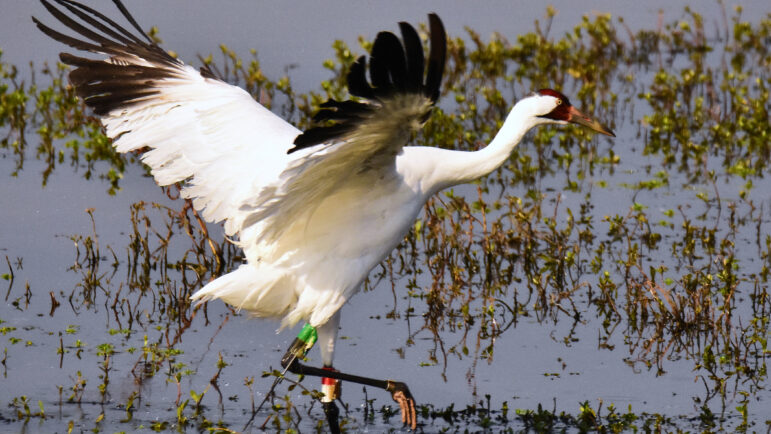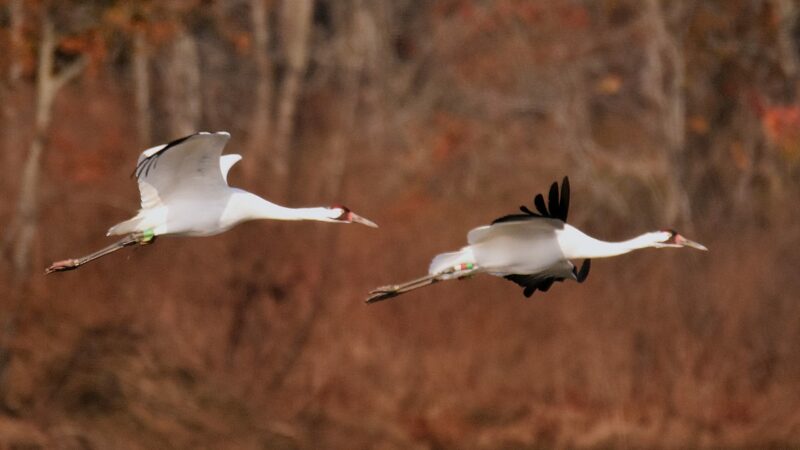Endangered Whooping Cranes Are Coming Back
Two endangered whooping cranes come in for a landing at Wheeler National Wildlife Refuge in Decatur, Alabama.
A couple extra wild birds in a creek doesn’t seem too important … until you realize that not long ago, there were barely 20 of them in the world. Whooping cranes are the tallest bird in America and they can live into their thirties, but that didn’t keep them from near-extinction. Now, though, thanks to decades of cooperation, they’re making a comeback. And you can see it — and definitely hear it — in Alabama.
Dozens of birdwatchers walk along a path near a marshy creek in Wheeler National Wildlife Refuge in Decatur. There are signs saying “quiet please,” but hundreds of cranes mock that plea with raucous cries.
Most of the symphony comes from sandhill cranes. But dotting the brown flock are a few endangered whooping cranes. Compared to the sandhill cranes, they’re fewer but bigger and brighter.

Amber Wilson of the International Crane Foundation says, “You’ll definitely be able to spot out the whooping cranes because they are about my height. They’re huge. They could look me in the eye, five feet tall. They have black on their wing tips. They’re bright white birds, and they also have that red patch on their heads.”

Wilson’s organization has been breeding whooping cranes since the 1970s. And this past summer in Wisconsin, a small wild flock the foundation helped start produced two new chicks. One is already at Wheeler. Two more wild whooping cranes might not sound like a lot, but, “two is very significant because to my knowledge, this is the first time that this has actually happened in this population. So these birds are going to grow up and they’re going to have amazing genetics, and they’re going to start having more chicks,” Wilson says. “We’re really happy about it.”
That’s partly because these birds had all but disappeared due to hunting and habitat destruction. In the 1940s there were barely 20 left in the wild. But people began trying to save them through captive breeding, land preservation, and rearing chicks with hand puppets. Biologists even taught the birds to migrate between Wisconsin and the Southeast by guiding them with small planes. And it wasn’t the planes the birds were following — it was the pilot wearing a full-body crane suit.
Anna Turkett, a lorikeet specialist at the Birmingham Zoo, understands the devotion.
“The cranes are really important to me because I feel like they’re a national treasure that’s in our backyard,” she says. “They’re such a comeback story and they’re so rare. And in Alabama, we don’t get those large beautiful animals. It’s so great to have them here in a place that’s so close to home.”

Wilson credits cooperation from conservation groups, government agencies, donors, and volunteers. And she credits the birds themselves:
“To have roughly 500 in the wild right now is extraordinary. These birds are actually really tough. They’ve found that some avian diseases that other birds are more susceptible to, cranes are not as susceptible to.”

In recent years, 20 or 30 whooping cranes have wintered in Wheeler. This year, conservationists hope that might rise to 40. If that happens, they say, it’s a good sign not just for the cranes but for the other species in those ecosystems.

AI images and internet rumors spread confusion about ICE agent involved in shooting
While the agent wore a mask in videos taken of the event, he appeared to be unmasked in many social media posts. That image appeared to have been generated by xAI's generative AI chatbot, Grok.
Photos: Protests grow over the fatal ICE shooting in Minneapolis
In cities across the country, demonstrators have expressed grief and outrage over the death of Renee Nicole Good, who was fatally shot by an Immigration and Customs Enforcement officer on Wednesday morning.
Doctors says ‘The Pitt’ reflects the gritty realities of medicine today
The Pitt is back for a new run, evoking the tensions health care providers face in the U.S. today. Here's what one doctor says to watch out for this season.
Why is the U.S. pulling out of 31 U.N. groups? And what’s the impact?
The Trump administration is withdrawing from 66 global groups, including U.N. entities that focus on climate and health issues.
Mamdani says New York child care expansion a real step to fulfilling campaign pledge
NYC Mayor Zohran Mamdani says a plan unveiled Thursday to take the first steps toward universal childcare for kids under five shows New Yorkers that "democracy can actually deliver for them."
A ‘medical situation’ is forcing NASA to end mission at the space station a month early
NASA says a crew member on the International Space Station is unwell. The agency canceled a planned spacewalk for Thursday and is taking the rare step of ending the Crew-11 mission early.








